Energy-Saving Streetlights Only Light Up When They Need To
This article is more than 2 years old
 Have you ever flown above a city at night and looked down upon empty street after empty street, lit up for seemingly no reason? You’re not alone. When Dutch designer Chintan Shah was a student at the Delft University of Technology in the Netherlands, he was inspired by the plethora of overused streetlights to create an innovative solution that only puts the lights to work when they’re actually needed, a system he calls Tvilight. It’s an idea you’ve no doubt entertained at some point, and probably not solely for dealing with streetlights. It’s a simple enough idea, but Shah turned it into an amazing reality.
Have you ever flown above a city at night and looked down upon empty street after empty street, lit up for seemingly no reason? You’re not alone. When Dutch designer Chintan Shah was a student at the Delft University of Technology in the Netherlands, he was inspired by the plethora of overused streetlights to create an innovative solution that only puts the lights to work when they’re actually needed, a system he calls Tvilight. It’s an idea you’ve no doubt entertained at some point, and probably not solely for dealing with streetlights. It’s a simple enough idea, but Shah turned it into an amazing reality.
After doing a little math, Shah discovered that, in Europe alone, over $13 billion is spent annually just powering streetlights, which comes out to over 40% of their annual energy bills, and over 40 million tons of CO2 emissions are released into the atmosphere due to this. (It equals 20 million cars, for those counting.) So he brought his idea to a campus competition, which he won, and was promptly given the money and facilities needed to turn his idea into a prototype. That prototype then turned into a fully functional lighting system that has been introduced into four municipalities in Holland and one in Ireland, and it isn’t stopping there. Shah says he’s gotten requests from the U.S., Australia, India, Isreal, Turkey, and Japan. Why is everybody all about it? It can potentially reduce energy costs and emissions by 80%, while also lowering maintenance costs by another 50%.
So let’s discuss exactly what this system does: anything, just about. Basically, there’s a sensor inside each streetlight that keeps it dimmed until either a car, bike, or pedestrian is nearby, which causes it to brighten up. The sensor will also alert electric companies when the light is burnt out or if there is a malfunction, rather than having lights go for months at a time without seeing any repairs. It doesn’t really need to get any more effective than that, but a whole host of interactive innovations are possible at this point. Take a look at the lights doing their job in the video below.
CNN brought in Dutch artist Daan Roosegaarde, who tossed out a host of ways that the streetlights could do more than just provide light. If the sensors are tapped into an emergency system, the lights could flicker red to alert anyone around that an ambulance or police car is coming through.
“It could save the ambulance two minutes because the light could tell everyone it’s coming,” said Shah, “and they could move aside more quickly because we control the streets, we control the lamps. It could save a life.”
In ideas more artistic than lifesaving, Roosegaarde envisions more personal touches, such as being able to program the lights to follow specific types of software. Want to impress your date? Interactive lights. They even wager sports scores could be expressed via the lights somehow. The options are endless at this early stage. We’ll just have to see how they use them.
Admittedly, unlike other cool light inventions, this one has a downside, in that part of a streetlight’s job is to keep streets safe. And while the sensors would catch criminals if they were clearly walking by, there are a number of ways this tech could be worked around. But we’re optimists here, so let’s bring the Tvilight to the States and see what happens.
Header image by Kris from Seattle, USA












